Biography
Brian Mathew was born in Limpsfield, a village in Surrey, England. His parents encouraged both Brian and his sister to look after small garden plots allocated to them. He records that as his father was a very successful vegetable gardener, his own interests were more in ornamental plants. An early encounter with Helleborus orientalis may have laid the foundations for a later monograph on hellebores. [2]
He was educated at the local grammar school. After leaving school he spent his compulsory military service in the Royal Air Force, engaged in a then secret project involving Britain's atomic bomb. When his service was finished, a family friend and enthusiastic gardener suggested he should attend the horticultural school run by the Royal Horticultural Society at Wisley. Entry required three years prior work experience. Through the offices of the family friend he was taken on at the nearby Birch Farm Hardy Plant Nursery, run by the Ingwersen family.
Having acquired the necessary work experience, he moved on to the RHS horticultural school. At the time the rock garden was cared for by Ken Aslet, well known to alpine garden enthusiasts, and botany was taught by Chris Brickell, with whom Mathew later collaborated. He met his wife, Margaret Briggs, at this time; she was Brickell's secretary.
In 1963, using a Bowles Scholarship travel grant, he organized a five-month plant hunting expedition to Iran. Many bulbs were collected, the areas visited being particularly notable for Crocus , Fritillaria and Iris . Subsequent trips to Turkey and the Balkans also focussed on bulbs, but also hellebores. These expeditions convinced Mathew that his interests lay more in botany than horticulture, and he found employment in the herbarium at the Royal Botanic Gardens, Kew. Initially, he worked in the tropical African section, but soon moved to the newly formed petaloid monocot section. His subsequent career at Kew was largely based on this group of plants, particularly the families Iridaceae, Liliaceae sensu lato and Amaryllidaceae.
In 1973, he published the first of his many books on bulbs or bulbous genera, Dwarf Bulbs. He has written that "[w]ith my combined interest in horticulture and taxonomy, I have tried to pitch my publications at a level which will to some extent appeal to a wide audience in both fields." Dwarf Bulbs was followed in 1978 by The Larger Bulbs, and a revision of the former work was published as The Smaller Bulbs in 1987. Between 1973 and 1992, he was the author or co-author of nine books on bulbs generally. In addition, he produced monographs of the genera Daphne (with Chris Brickell), Iris , Crocus , Lewisia , and Helleborus in addition to contributing accounts of various families or genera to at least nine different floras, and producing over 200 papers in botanical and horticultural journals.
In 1982, Mathew was awarded by The British Iris Society, the Foster Memorial Plaque (named after Sir Michael Foster). [3]
This prodigious output of scholarly and more popular works lead to two awards at the beginning of the 1990s. In 1991, he was awarded the Victoria Medal of Honour, by the Royal Horticultural Society. [4] In 1992, he was awarded the Herbert Medal by the International Bulb Society – only one recipient is honoured worldwide each year. [5]
He continued to write, with some 13 authored or co-authored books published between 1993 and 2005, many on bulbs or bulbous genera, such as Lilies : a romantic history with a guide to cultivation (1993) or The Cyclamen of Turkey (2001, with Neriman Özhatay). More recently he contributed to a book on Epimedium (2002) and other herbaceous Berberidaceae and to one on the genus Sorbus (2005).
He was awarded an MBE in the 2005 New Year Honours. [6]

Crocus is a genus of seasonal flowering plants in the family Iridaceae comprising about 100 species of perennials growing from corms. They are low growing plants, whose flower stems remain underground, that bear relatively large white, yellow, orange or purple flowers and then become dormant after flowering. Many are cultivated for their flowers, appearing in autumn, winter, or spring. The flowers close at night and in overcast weather conditions. The crocus has been known throughout recorded history, mainly as the source of saffron. Saffron is obtained from the dried stigma of Crocus sativus, an autumn-blooming species. It is valued as a spice and dyestuff, and is one of the most expensive spices in the world. Iran is the center of saffron production. Crocuses are native to woodland, scrub, and meadows from sea level to alpine tundra from the Mediterranean, through North Africa, central and southern Europe, the islands of the Aegean, the Middle East and across Central Asia to Xinjiang in western China. Crocuses may be propagated from seed or from daughter cormels formed on the corm, that eventually produce mature plants. They arrived in Europe from Turkey in the 16th century and became valued as an ornamental flowering plant.

Iris is a flowering plant genus of 310 accepted species with showy flowers. As well as being the scientific name, iris is also widely used as a common name for all Iris species, as well as some belonging to other closely related genera. A common name for some species is flags, while the plants of the subgenus Scorpiris are widely known as junos, particularly in horticulture. It is a popular garden flower.

Leucojum is a small genus of bulbous plants native to Eurasia belonging to the amaryllis family, subfamily Amaryllidoideae. As currently circumscribed, the genus includes only two known species, most former species having been moved into the genus Acis. Both genera are known as snowflakes.
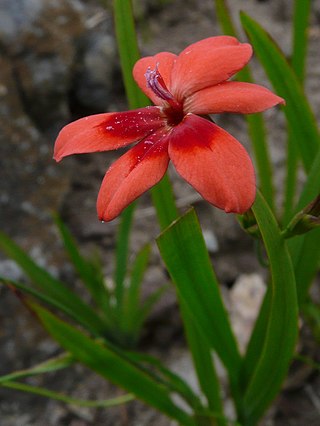
Freesia laxa, commonly known as flowering grass, is a small species of cormous flowering plant in the family Iridaceae, from eastern and southern Africa, from Kenya to northeastern South Africa. It is grown in gardens as an ornamental plant.

Puschkinia is a genus of four known species of bulbous perennials in the family Asparagaceae, subfamily Scilloideae. It is native to the Caucasus and the Middle East. Puschkinia scilloides is grown as an ornamental bulbous plant.
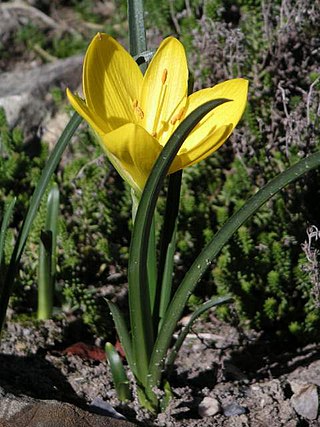
Sternbergia lutea, the winter daffodil, autumn daffodil, fall daffodil, lily-of-the-field, or yellow autumn crocus, is a bulbous flowering plant in the family Amaryllidaceae, subfamily Amaryllidoideae, in the Narcisseae tribe, which is used as an ornamental plant. It has yellow flowers which appear in autumn.

Muscari neglectum is a perennial bulbous flowering plant in the asparagus family Asparagaceae. Members of this genus are commonly known as grape hyacinths, and M. neglectum is known as common grape hyacinth or starch grape hyacinth. Muscari are perennial bulbous plants native to Eurasia. They produce spikes of dense, commonly blue, urn-shaped flowers. It is sometimes grown as an ornamental plant, for example, in temperate climates as a spring bulb.

Muscari armeniacum is a species of flowering plant in the squill subfamily Scilloideae of the asparagus family Asparagaceae. It is a bulbous perennial with basal, simple leaves and short flowering stems. It is one of a number of species and genera known as grape hyacinth, in this case Armenian grape hyacinth or garden grape-hyacinth. The flowers are purple, blue, white or pale pink and the plants are usually 15 centimetres (6 in) tall. M. armeniacum blooms in mid-Spring for 3–4 weeks. Some selections are fragrant. Established bulbs leaf in the autumn. M. armeniacum is widespread in the woods and meadows of the Eastern Mediterranean, from Greece and Turkey to the Caucasus, including Armenia which gives it its name.
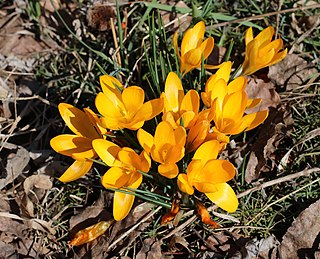
Crocus flavus, known as yellow crocus, Dutch yellow crocus or snow crocus, is a species of flowering plant in the genus Crocus of the family Iridaceae. It grows wild on the slopes of Greece, former Yugoslavia, Bulgaria, Romania and northwestern Turkey, with fragrant bright orange-yellow flowers. It is a small crocus (5–6 cm, despite the names of some cultivars, compared to the giant Dutch crocuses. Its cultivars are used as ornamental plants.

Crocus sieberi, Sieber's crocus, also referred to as the Cretan crocus or snow crocus, is a plant of the genus Crocus in the family Iridaceae. A small, early blooming crocus, it easily naturalises, and is marked by a brilliant orange which is mostly confined to the stamens and style, fading through the bottom third of the tepal. It grows wild generally in the Balkans: Greece, especially in the island of Crete, Bulgaria, Albania and North Macedonia. There are four subtypes: sieberi (Crete), atticus, nivalis and sublimis. Its cultivars are used as ornamental plants. Height: 3–4 inches (7.6–10.2 cm).
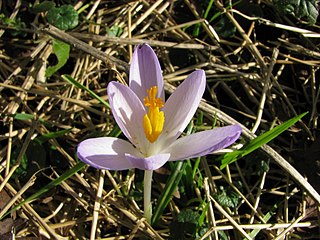
Crocus tommasinianus, the woodland crocus, early crocus, or Tommasini's crocus, is a flower named after the botanist Muzio G. Spirito de Tommasini (1794-1879). It is native to Bulgaria, Hungary, Albania, and the former Yugoslavia. It is often referred to as the early or snow crocus, but these terms are shared with several other species, although C. tommasinianus is amongst the first to bloom. Multiple plants are often called tommies in the horticultural trade.

Ornamental bulbous plants, often called ornamental bulbs or just bulbs in gardening and horticulture, are herbaceous perennials grown for ornamental purposes, which have underground or near ground storage organs. Botanists distinguish between true bulbs, corms, rhizomes, tubers and tuberous roots, any of which may be termed "bulbs" in horticulture. Bulb species usually lose their upper parts during adverse conditions such as summer drought and heat or winter cold. The bulb's storage organs contain moisture and nutrients that are used to survive these adverse conditions in a dormant state. When conditions become favourable the reserves sustain a new growth cycle. In addition, bulbs permit vegetative or asexual multiplication in these species. Ornamental bulbs are used in parks and gardens and as cut flowers.

Scilla sardensis, the lesser glory-of-the-snow, is a bulbous perennial from west Turkey flowering in early spring. After flowering, it goes into dormancy until the next spring. It belongs to a group of Scilla species that were formerly put in a separate genus, Chionodoxa, and may now be treated as Scilla sect. Chionodoxa.

Iris tuberosa is a species of tuberous flowering plant of the genus Iris, with the common names snake's-head, snake's-head iris, widow iris, black iris, or velvet flower-de-luce.

Muscari aucheri, Aucher-Éloy grape hyacinth, is a species of flowering plant in the squill subfamily Scilloideae of the asparagus family Asparagaceae. It is a perennial bulbous plant, one of a number of species and genera known as grape hyacinths. Originally from Turkey, where it grows in grassy alpine areas, it is sometimes grown as an ornamental plant. The synonym M. tubergenianum may be found in the horticultural literature.
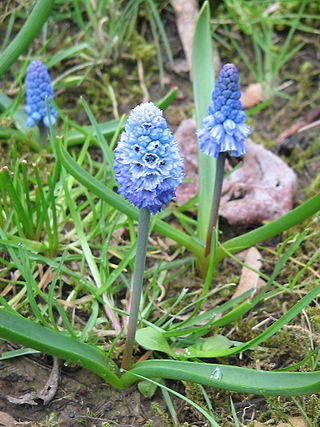
Pseudomuscari azureum, the azure grape hyacinth, is a species of flowering plant in the family Asparagaceae, native to Turkey. A bulbous perennial, it is grown in gardens for its spring flowers. The Latin specific epithet azureum means "bright blue", a reference to its flower colour.

Crocus biflorus, the silvery crocus or scotch crocus, is a species of flowering plant in the family Iridaceae. It is native to south-eastern Europe and south-western Asia, including Italy, the Balkans, Ukraine, Turkey, Caucasus, Iraq, and Iran. It is a cormous perennial growing to 6 cm (2.4 in) tall and wide. It is a highly variable species, with flowers in shades of pale mauve or white, often with darker stripes on the outer tepals. The flowers appear early in spring.

Iris histrio, the Syrian iris, is a species in the genus Iris, it is classified in the subgenus Hermodactyloides and section Reticulatae. It is a bulbous perennial from Central Asia: Kyrgyzstan, Israel, Lebanon, Syria and southern Turkey.
Iris subg. Nepalensis is one subgenus of Iris, also known as 'Himalayan irises'. It was formerly genus Junopsis.
Peter Goldblatt is a South African botanist, working principally in the United States.

















